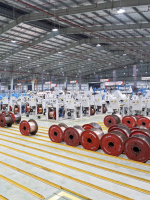
Providing clean electricity
Located in the Nam Son Waste Treatment Complex, Soc Son District, the plant is managed and operated by the Hanoi Thien Y Environmental Energy Joint Stock Company. It features five incinerators capable of receiving and processing approximately 5,000 tonnes of waste daily, with a power generation capacity of 90 MW. The plant has played a crucial role in solid waste treatment, reducing pollution, and converting waste into electricity to support the capital’s socioeconomic development.
Since its launch in 2019, the plant has yielded positive environmental benefits for Hanoi.
The Soc Son Waste-to-Energy Plant has experienced stable operation in the first and second phases, with five incinerators with a daily burning capacity of 4,000 tonnes, a reception capacity of 5,000 tonnes, and two power generation units with a capacity of approximately 60 MW, meeting the highest environmental standards set by Vietnam and the EU 2010.
The plant has completed trial operations in the third phase and is ready to bring the total power generation capacity to 90 MW.
According to Do Tien Dung, Deputy General Director of the Hanoi Thien Y Environmental Energy Joint Stock Company, the waste treatment process is conducted in a closed and safe manner. The process includes waste reception, storage in waste pits for mixing and drying before incineration, and energy recovery from combustion for power generation, which is then fed into the national grid to support socioeconomic development.
The Soc Son Waste-to-Energy Plant has helped Hanoi gradually achieve its goal of reducing landfill waste, aligning with the city’s green, clean, modern, and civilized development orientation.
Processing 70 percent of Hanoi’s waste
According to the Hanoi Department of Natural Resources and Environment, the city generates 6,500-7,000 tonnes of waste daily, with landfill being the primary disposal method. However, major landfills, such as Nam Son and Xuan Son, are reaching full capacity, posing significant environmental risks.
The Soc Son Waste-to-Energy Plant has effectively processed 70 percent of Hanoi’s daily waste, gradually improving the city’s environmental conditions.
Waste-to-energy technologies also help conserve and utilize land resources more efficiently. Landfills require hundreds of years before they can be repurposed, and surrounding areas often suffer from severe air and water pollution. Meanwhile, waste-to-energy projects create jobs for local residents, contributing to employment and economic stability.
The Hanoi Thien Y Environmental Energy Joint Stock Company recently proposed adding two more incinerators, each with a capacity of 800 tonnes per day, increasing the plant’s total to seven incinerators. This expansion aims to process previously buried waste at Nam Son landfill. The proposal has received support from the city authorities, as it enhances the processing capacity without requiring additional land, effectively addressing environmental issues while maximizing land resource efficiency.
“In 2025, the Soc Son Waste-to-Energy Plant aims to generate 600 million kWh for the national grid, maintaining its position as a pioneer in environmental protection innovation,” Do Tien Dung affirmed./.
Thu Huong




